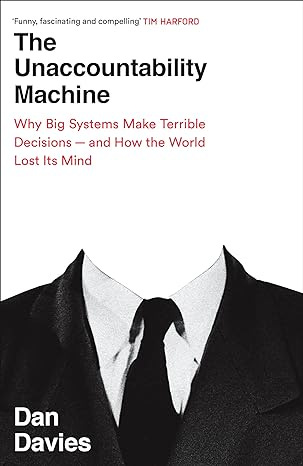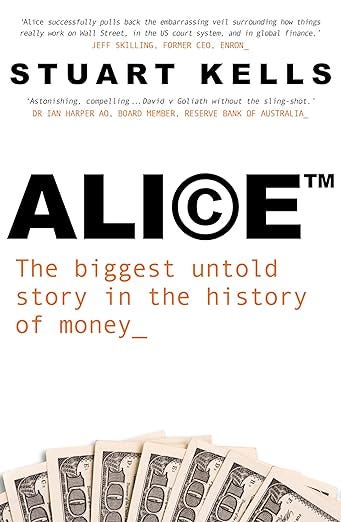It’s complicated: Me on complexity
It’s complicated: Me on complexity
My exceedingly generous friend Rory Sutherland suggested that Sean Brady, the host of the excellent podcast Simplifying Complexity, interview me. So Sean dutifully contacted me and here we are in this interview. Having listened to some former episodes, I asked if Sean would be OK with me going the mild debunk on complexity theory. We’re always hearing that we need a ‘new paradigm’, but I argue that, our problems are more mundane than that — and more difficult. A few paradigms could defs do with a touch-up. But most of our problems stem from not using the paradigms we have properly. We slavishly apply them, with little regard for their strengths and weaknesses and little humility more generally about how little we know and how hard it is to know more.
In areas like economics, beyond the extremely useful service that economics from Adam Smith to Keynes performs for us in organising the material to help us think about very general questions, we just don’t know very much. And if modelling ‘complexity’ doesn’t show you that, nothing will. And yes, we should be experimenting with different frameworks for modelling finance.
There’s another issue which is that treating the economy as an object — which like other modelling, complexity approaches typically do — this overlooks the extent to which our problems arise elsewhere, and particularly from the ethical life that goes on inside our institutions. But the solution there isn’t some new formal model, but as the late great John Hicks said aeons ago, as determinate models lose their power, economics has to start looking more like history — more discursive, less physics-like.
Anyway, I hope you enjoy the podcast.
50 years as Australia’s leading economics journalist
A very nice appreciation of some old guys from John Quiggin.
For quite a while I’ve been meaning to write a piece appreciating Ross Gittins’ 50 year run as Australia’s leading economic journalist. … This plan was pushed to the top of my agenda when Ross gave an exceptionally generous donation to support my Brissie to the Bay cycle ride in support of MS Queensland. It reminded me of the generosity of spirit Ross has displayed throughout his career. [Ross, who comes from old Salvation army stock, has been similarly generous in helping me raise money for refugees.] …
Back in the Whitlam era, “economic rationalist” wasn’t the pejorative term it has now become; in fact, Whitlam saw himself as an economic rationalist. As I wrote quite a while ago
‘Economic rationalism’ then referred to policy formulation on the basis of reasoned analysis, as opposed to tradition, emotion and self-interest. With the exception of support for free trade, there was no presumption in favour of particular policy positions. The views of the first generation of economic rationalists were generally in the economic mainstream of the period — Keynesian in macro terms and supportive of the ‘mixed economy’ in micro terms.
Understood in those terms, Ross was, and remains an economic rationalist. But
During the period of the Fraser and Hawke governments, both the intellectual character and the theoretical and policy content of economic rationalism changed. The critical and sceptical thinking that characterised the first phase of economic rationalism was gradually replaced by a dogmatic, indeed, quasi-religious, faith in market forces and the private sector
Unlike many others, Ross did not follow this path. Instead, he reacted against it, looking for an understanding of economics that was more realistic and humane. This has been a consistent feature of his later writing. Ross has regularly criticised models of economic behavior based on narrowly defined self interest and promoted richer models of people’s goals and motivation.
The other thing I appreciate most about Ross is his willingness to engage with the academic economics profession, rather than taking talking points from corporate and bank economists, like so many other economic journalists. I particularly remember his description of the late Fred Gruen as a ‘useful economist’, that is, one who made serious contributions to Australian public policy rather than focusing on high-status publications in international journals.
I’ve always aspired to follow in Fred’s footsteps in this regard, though I found it necessary to do the international journal stuff as well in order to maintain credibility while pushing leftwing policy views. …

Some thoughts on HECS
An interesting two-part post that explored the idea of a graduate tax as an alternative to HECS. It brought to mind some thoughts I had and things I did way back when it was first set up — and in fact before that. As I commented:
I was a staffer in the (then) new ALP Government in 1984 and suggested income contingent loans to the (then) Minister for Education Susan Ryan in the corridors of the Senate. She said that was much bolder than the government fancied being. Anyway Dawkins succeeded her and was more gung ho. I didn't much go for the way it was designed. The Wran Committee proposed that just 20% of the cost of tuition be met — on the grounds that many of the benefits of education were external. But since education in general generates benefits well beyond cost to the individual themselves, this didn't seem to make much sense to me.
Moreover they didn't seem to integrate equity into the scheme. Beyond the basic idea that people should contribute (because without this education was a subsidy by the — poorer — less educated of the — richer — educated) the logic on equity went no further.
I thought it might be reasonable for average graduates earning not so much to meet 20% of the cost of their degrees — teachers, nurses, social workers, army officers and so on. But why wouldn’t you up this for those who end up being very highly paid. 100% of costs was fine with me. But so too was 150% for people in the top — say 5% — of the income distribution. And if that's the case, what's wrong with just having a higher tax rate for such people and forget the fancy accounting for the cost of their education?
Anyway, in the same sweep of policy the ALP reduced the top marginal rate from 60% (or perhaps a tad more given the Medicare levy) to 49.5% and then Keating fought a long and fortunately ultimately unsuccessful campaign to reduce it to 30. That was bad for equity and bad for efficiency too if you think that the ultimate output of the economy is utility or wellbeing not dollars.
Anyway, you follow this logic and I'm not sure you don’t end up where you started in 1982 — free tertiary education, but higher taxes on the wealthy. Another option to consider among the ones you do.
Cooperating with China’s plans to make 10 million EVs p.
Dean Baker points out that, while America fights with China, there remains good reasons for it to cooperate. It’s strange how we let that slip from our view, but even with Russia, there’s a vital interest in all those areas outside the war we’re having with it. The main thing we should be cooperating with Russia on, we probably already are somewhat which is that there remain back-channels by which the Americans and Russians can try to minimise the chances of blowing themselves up. Anyway, here’s Dean Baker on how America should think of the Great Wall of ten million EVs a year that China has in the pipeline.
After worrying for decades that the price of EVs was too high, we now have a different problem, the price is too low. China is now producing over ten million electric cars a year, some carrying price tags of under $10k. This has prompted terror here, with politicians tripping over themselves to find ways to keep people from buying them.
The concern is that it will wipe out the domestic U.S. auto industry. After telling us for decades that Americans don’t want to buy electric cars, people like Donald Trump are yelling about how we have to take strong measures, like 100 percent tariffs, to prevent them from buying electric cars.
This would be great comedy, except that it is a huge issue, and no one apparently cares that politicians are inconsistent. But those of us who are not running for office have the ability to talk about the issue seriously.
First, if China wants to export cheap EVs to the world, we should see that as a good thing, not an act of war. The flat-earth society may not believe in global warming, but the rest of us don’t have that luxury. Tens of millions of low-cost EVs being sold around the world in the next few years would hugely help advance the effort to slow emissions. If China wants to subsidize this process, we should be thanking them.
At the same time, it does make sense for us to protect our domestic industry. We do have a genuine national security interest in not being dependent on China for our cars. [Really? What’s wrong with only getting half-way to self-sufficiency which I imagine the US could do on its ear?]
We can do this by stealing a page from Ronald Reagan. In the 1980s the U.S. auto industry’s survival was seriously threatened by a flood of imports from Japan. Reagan responded by getting Japan to agree to voluntarily export restraints on the number of cars they sold in the United States. [It’s much smarter to impose quotas and then auction them — that way the importing country captures the scarcity rent generated by constraining imports.] …
Since China will have capacity to export more EVs than the United States and other wealthy countries are willing to import, we can work together with China to promote their export to developing countries that currently lack a domestic car industry. [This is all very binary — surely countries with car industries can import some Chinese EVs.]
In many poorer countries the EVs would be replacing older cars that spew large amounts of emissions. … This would be a great way to work with China to further our common goal of slowing global warming. Politicians like to compete about who is tougher on China. That might be fun theater, but the entertainment is not worth our time.

The CIS chief economist unimpressed with Peter Dutton
Clever and funny
Felix Martin reviews The Unaccountability Machine
On the strength of Felix’s recommendation, I’m now halfway through The Unaccountability Machine and really enjoying it. In addition to being about a pressing issue, it takes you through a byway that’s been ignored: Management cybernetics. I wouldn’t argue that adopting it would give you the royal road to sorting out complexity in the organisation. That’s much too tough a problem, which will be with us until the four horsemen of the apocalypse come riding over the horizon (which may not be that far away, but I digress!)
However just being introduced to some of its basic ways of understanding the core functions of management and how they relate to each other, it’s remarkable that it’s not part of the core curriculum of management education. Remarkable, but not surprising. What goes into curricula is there mostly because it’s there. Why is triggernometry still in the high school maths curriculum but stats isn’t? No reason. No one got around to changing it. But then, as management cybernetics tells you, that’s a failure of System 4.
Waiting to board a flight recently, I witnessed a stark example of a phenomenon at the heart of The Unaccountability Machine. A fellow passenger had been refused boarding and was pleading with the airline attendant. The attendant was obviously sympathetic — but the refusal was company policy. It was as frustrating for her as for the passenger, but there was unfortunately nothing she could do.
We were witnessing what Dan Davies calls an “accountability sink”: a situation in which a human system delegates decision-making to a rule book rather than an identifiable individual. If something goes wrong, no one is held to account.
The starting point of Davies’s entertaining, insightful book is that … accountability sinks … influence reaches far beyond frustrated customers endlessly on hold to “computer says no” service departments. In finance, banking crises regularly recur — yet few individual bankers are found to be at fault. If politicians’ promises flop, meanwhile, they complain they have no power. The Deep State is somehow to blame.
The origin of the problem, Davies argues, is the managerial revolution that began after second world war, abetted by the advent of cheap computing power and the diffusion of algorithmic decision-making into every sphere of life. These systems have ended up “acting like a car’s crumple zone to shield any individual manager from a disastrous decision,” he writes. While attractive from the individual’s perspective, they scramble the feedback on which society as a whole depends. …
Davies argues, there exists a … better way — one much less familiar to most of us. This is “management cybernetics”, a framework for understanding the corporate and economic world that emerged from operations research, the use of mathematics to solve problems of human and technical resource management that began during the second world war.
Davies’s hero here is the management consultant, information theorist, and philosopher Stafford Beer, whose heyday in the 1960s and 70s saw him advise CEOs and governments around the world. Beer conceived of companies as forms of non-human intelligence — what the science fiction writer Charlie Stross calls “very old, very slow AIs”. As such, solving their problems is a matter not of eliminating market failures, but of ensuring that the flow of information between deciders and decided-upon is kept in balance. When our challenge is, as now, that “the artificial intelligences that rule our lives have gone mad”, the solution is therefore not economics, but cybernetics: a kind of psychoanalysis for non-human intelligences, with Stafford Beer as Sigmund Freud. …
Half Empty and Half Full? Women in Economics and the Rise in Gender-Related Research
Francisca M. Antman, Kirk B. Doran, Xuechao Qian, and Bruce A. Weinberg #32442
Abstract:
Using the EconLit dissertation database and large-scale algorithmic methods that identify author demographics from names, we investigate the connection between the gender of economics dissertators and dissertation topics. Despite stagnation in the share of women among economics Ph.D.s in recent years, there has been a remarkable rise in gender-related dissertations in economics over time and in many sub-fields. Women economists are significantly more likely to write gender-related dissertations and bring gender-related topics into a wide range of fields within economics. Men in economics have also substantially increased their interest in gender-related topics.
Money isn’t what you think it is (seriously!)
An amazing story about a friend of mine, Ian Shepherd by a friend of mine Stuart Kells who met at a party I held (would you believe?). So that is a cool thing. In any event, as the blurb informs us
The extraordinary story of Alice Corporation, a company created to reimagine financial markets, brings together an unlikely cast of characters- renowned author Kate Jennings, international banking insider Ian Shepherd, Enron CEO Jeffrey Skilling, German-born World War II historian Sigrid MacRae, J.P. Morgan deputy chair Roberto Mendoza - and his dog, Stanley.
In the tradition of Michael Lewis's Flash Boys and The Big Short, Alice is a story of ground-breaking insights, legal intrigue and improbable friendships. Pinpointing the likely causes of the next financial crisis, Alice reveals the fight to build a safer, fairer financial future.
The extract below is is not an extract from the book but from a simple article Stuart wrote about money — and how wrong we have it. The book takes up where it leaves off.
I’ve spent many hours digging into the financial basement, getting my head around inter-bank payment systems, foreign exchange settlement arrangements, the fine print of derivatives contracts, and the normally unseen workings of banks and trading platforms.
Financial inventor Ian Shepherd led me down there. Shepherd is an international expert in payment systems and the design of financial markets. His ‘Alice market’ was the subject of the famous 2014 US Supreme Court case Alice v. CLS. It is also the subject of my 2024 book, Alice.
As a relative novice in the basement, I was struck by the gulf between how money, banking and finance are commonly understood and how things actually work down at the foundations.
To help explain the gulf, here’s a quick bit of ‘Money and Banking 101’.
The word ‘money’ refers to many different things including coins, banknotes, bank deposits and bank ‘reserves’. Right now, coins and banknotes are becoming less and less important as a form of money — so much so that armoured transport companies are going out of business.
Bank deposits (including checking and savings accounts) are by far the most important category of money. They are the dominant form used in financial markets, for example, and they are the principal means by which taxes are paid and goods and services are bought. …
When speaking of everyday banking, people use phrases such as ‘putting money in my account’; and they conceive of inter-bank transfers as involving the movement of money from one account to another. This kind of phrasing is nearly universal. …
According to this idea, commercial banks use a proportion of their customers’ deposits to make loans, while holding back some of the money as reserves, for use when needed, such as if there is a shortage of money to cover requests for withdrawals.
In a ‘run’ on deposits, as it is generally understood, a bank is at risk because money in deposit accounts is not immediately available to return to customers; much of the money has been ‘lent out’, and the bank cannot ‘call in’ loans quickly enough to satisfy the demand for withdrawals.
The intuitive understanding of money also extends to taxation and public finance. In that understanding, the tax collecting authorities gather money that is then used for various public purposes, principally government spending.
Viewed from the level of the financial plumbing and individual payment steps, the intuitive view of money and banking breaks down. The reality is very different.
At the most fundamental level, for example, the ‘money’ in a bank account has no separate existence from the stated account balance, which is effectively a record of an IOU from the bank. A positive deposit account balance is no more than a record of the deposit holder’s status as an unsecured creditor of the bank.
Contrary to a common belief, bank deposits are not and cannot be used as the basis for loans. When loans are created, the associated balances are created anew, not out of existing deposits or some other form of money. Banks do not intermediate between borrowers and lenders, and nor do they hold a proportion of customer deposits as reserves. ‘Fractional reserve banking’ is neither a useful nor accurate description of how modern banking works.
Banks don’t gather deposits to make loans — and nor do they collect repayments to use as the basis for new loans or for other purposes. When a bank receives repayments, those funds cancel out a proportion of the money that was created when the loan was first written. The money used for the repayments therefore ‘disappears’ at the moment they are made. …
So what? Why are these differences in understanding important?
Nobody will ever write a book about my mother
Paul Graham faces his fears
HT: @michael_nielsen
Asia’s crashing population
When I see an article I think I’ll like and want to show you; I sometimes copy it, paste it here and edit out what can be left out and still leave the guts. That’s how I began work on this article. I thought it would be more interesting than it is. Its facts are striking and interesting. And the upshot? Well, ageing, removing prime-age workers from your workforce isn’t a problem if you can compensate with faster productivity or healthier ageing. But you can say that in a sentence or in 1,000 or more words. You got the sentence but if you’d like another 1,000 words on it, click through and go for your life. Oh — and other things being equal falling relative population means falling relative military strength. (unless you have higher military productivity or better ageing. Did I mention something like that before?) Anyway, there you have it.
China, Japan, South Korea, and Taiwan—are about to enter into an era of depopulation, in which they will age dramatically and lose millions of people. … and Japan’s populations are set to fall by eight percent and 18 percent, respectively, between 2020 and 2050. South Korea’s population is poised to shrink by 12 percent, Taiwan’s by eight percent. The U.S. population, by contrast, is on track to increase by 12 percent.
People—human numbers and the potential they embody—are essential to state power. All else being equal, countries with more people have more workers, bigger economies, and a larger pool of potential soldiers. As a result, growing countries find it much easier to augment power and extend influence abroad. Shrinking ones, by contrast, struggle to maintain their sway.
East Asian countries will … find it harder to generate economic growth, accumulate investments, and build wealth; to fund their social safety nets; and to mobilize their armed forces. They will face mounting pressure to cope with domestic or internal challenges. Accordingly, Japan, South Korea, and Taiwan will be prone to look inward. China, meanwhile, will face a growing—and likely unbridgeable—gap between its ambitions and capabilities. … But the drag on East Asia’s democracies will create problems for Washington. These states will become less attractive partners for the United States, just as their need for partnership with the United States grows.…
Between 1950 and 1980, [East Asia’s population] increased by almost 80 percent. By 2020, the region had almost 2.5 times as many inhabitants as in 1950. … But even as East Asia’s population rose, the underlying trend lines presaged a coming decline. In Japan in the early 1970s, fertility fell below the replacement level. In the 1980s, the same thing happened in South Korea and Taiwan. China—the giant that accounts for five-sixths of East Asia’s total population—followed suit in the early 1990s. Since then, the region’s fertility has fallen even farther below replacement. As of 2023, Japan is East Asia’s most fertile country, even though its childbearing levels are over 40 percent below the replacement rate. China’s childbearing levels are almost 50 percent below the replacement rate; if that trend continues, each rising Chinese generation will be barely half as large as the one before it.…
This demographic shift will cost these countries more than just their youth. It also threatens to sap them of economic vitality. …
The article then says this about three different ways — ageing and demographic decline can be made up for with faster productivity growth, or healthier aging. And demographic decline also means military decline.
Some lovely things



Unaccountability sinks
From the Unaccountability Machine reviewed above.
The accountability sinks
Bad things were happening, but they didn’t seem to be anybody’s fault. This was infuriating to everyone; the CEOs, political leaders and other figureheads had been drawing big salaries and bonuses, and telling all of us that they knew best, but it turned out that they didn’t even know what was going on in their own organisations. There was no mechanism to punish individual human beings, so the hoi polloi defaulted to what seemed like the only alternative – to use the democratic powers available to them to tear down the whole system.
The relationship between experts, decision makers and the general public had become completely dysfunctional. This wasn’t really a crisis of managerialism or a crisis of political legitimacy – it was a crisis of accountability. And if accountability was at the root of the crisis, then maybe the things to look at were the mechanisms that cause it to be diminished.
Consider, for example, the following situation. A characteristically modern form of social interaction, familiar from the rail and air travel industries, has become ubiquitous with the development of the call centre. Someone – an airline gate attendant, for example – tells you some bad news; perhaps you’ve been bumped from the flight in favour of someone with more frequent flyer points. You start to complain and point out how much you paid for your ticket, but you’re brought up short by the undeniable fact that the gate attendant can’t do anything about it. You ask to speak to someone who can do something about it, but you’re told that’s not company policy.
The unsettling thing about this conversation is that you progressively realise that the human being you are speaking to is only allowed to follow a set of processes and rules that pass on decisions made at a higher level of the corporate hierarchy. It’s often a frustrating experience; you want to get angry, but you can’t really blame the person you’re talking to. Somehow, the airline has constructed a state of affairs where it can speak to you with the anonymous voice of an amorphous corporation, but you have to talk back to it as if it were a person like yourself.
Bad people react to this by getting angry at the gate attendant; good people walk away stewing with thwarted rage, and they may give some lacerating feedback online. Meanwhile, the managers who made the decision to prioritise Gold Elite members are able to maximise shareholder value without any distractions from the consequences of their actions. They have constructed an accountability sink to absorb unwanted negative emotion.
The fundamental law of accountability
It is important to be clear, at this stage, exactly what an accountability sink is, and how they are constructed.* It’s not just the way in which the hourly paid worker has been set up to act as a human shield. In order to make the sink effective, you need a combination of things: that person, plus a policy that there’s no way to appeal the decision by communicating with a higher level of management. (Even if you somehow managed to get the CEO’s phone number, you would come up against the fact that the policy was in place precisely to protect them from making that decision personally.)
So the crucial thing at work here seems to be the delegation of the decision to a rule book, removing the human from the process and thereby severing the connection that’s needed in order for the concept of accountability to make sense. You could even coin a sort of law of management here:
The fundamental law of accountability: the extent to which you are able to change a decision is precisely the extent to which you can be accountable for it, and vice versa.
The construction of accountability sinks has damaging implications for the flow of information. For an accountability sink to function, it has to break a link; it has to prevent the feedback of the person affected by the decision from affecting the operation of the system. The decision has to be fully determined by the policy, which means that it cannot be altered by any information that wasn’t anticipated. If somebody can override the accountability sink and overrule a policy that is in danger of generating a ridiculous or disgusting outcome, then that person is potentially accountable for the outcome.
When an organisation decides to create an accountability sink, it’s taking a risk. Implicitly, every rule is a model of the world – you can see both a model and a rule book as a relationship between causes and effects, inputs and outputs. But because they can’t be a model of the whole world, both a rule book and a model have to leave out a lot of detail. That means that, like a model, a rule has to be based on assumptions about the kinds of situations that might need to have decisions made about them. So a notice on the wall of an office that says ‘STAFF HAVE NO ACCESS TO THE SAFE’ implies a set of assumptions about the kind of person who might walk in off the street and ask staff to open the safe, while a notice that says ‘NO REFUNDS – NO EXCEPTIONS’ carries an implicit assumption that there will never be a case where a customer is entitled to a refund.
When an unanticipated situation arises – either because something unusual has happened, or because the accountability sink was badly designed – there will be a mismatch between the input that the system anticipated, and what it actually got. And, because the system has been designed to work as an accountability sink, the outcome could be gruesome or absurd. Consider, for example, the tale of an airline and a few hundred furry mammals.
The squirrel shredders of Schiphol
Back in the 1990s, ground squirrels were briefly fashionable pets, but their popularity came to an abrupt end after an incident at Schiphol Airport on the outskirts of Amsterdam. In April 1999, a cargo of 440 of the rodents arrived on a KLM flight from Beijing, without the necessary import papers. Because of this, they could not be forwarded on to the customer in Athens. But nobody was able to correct the error and send them back either. What could be done with them?
It’s hard to think there wasn’t a better solution than the one that was carried out; faced with the paperwork issue, airport staff threw all 440 squirrels into an industrial shredder, apart from a few that had previously escaped from the animal containment facility. In later weeks, it transpired that this shredder was a specialised piece of machinery used in the poultry industry to dispose of worthless male chicks. Before the story hit the headlines, ground staff had over a period of months shredded 200 other squirrels, several dozen water turtles and a small flock of parakeets.
The press release in which KLM apologised for this horrible fiasco was a masterpiece of the genre that’s still studied in business schools as an effective example of crisis PR. But it’s less fascinating for its deflection of blame than for the underlying system that it revealed.
It turned out that the order to destroy the squirrels had come from the Dutch government’s Department of Agriculture, Environment Management and Fishing. However, KLM’s management, with the benefit of hindsight, said that ‘this order, in this form and without feasible alternatives,* was unethical’. The employees had acted ‘formally correctly’ by obeying the order, but KLM acknowledged that they had made an ‘assessment mistake’ in doing so. The company’s board expressed ‘sincere regret’ for the way things had turned out, and there’s no reason to doubt their sincerity.
So what went wrong, and who was responsible for shredding the squirrels? The first question is easier to answer than the second. KLM had set up a system whereby decisions about animals with the wrong import paperwork were left to someone at the agriculture department. In doing so, everyone involved had accepted that a low baseline level of animal destruction was tolerable – which is why they bought the poultry shredder. But, in so far as it is possible to reconstruct the reasoning, it was presumed that the destruction of living creatures would be rare, more used as a threat to encourage people to take care over their paperwork rather than something that would happen to hundreds of significantly larger mammals than the newborn chicks for which the shredder had been designed.
The characterisation of the employees’ decision as an ‘assessment mistake’ is revealing; in retrospect, the only safeguard in this system was the nebulous expectation that the people tasked with disposing of the animals might decide to disobey direct instructions if the consequences of following them looked sufficiently grotesque. It’s doubtful whether it had ever been communicated to them that they were meant to be second-guessing their instructions on ethical grounds; most of the time, people who work in sheds aren’t given the authority to overrule the government. In any case, it is neither psychologically plausible nor managerially realistic to expect someone to follow orders 99 per cent of the time and then suddenly act independently on the hundredth instance.
For their part, the people in the agriculture ministry were a long way from the workers who had to carry out their instructions. They had a responsibility to protect the biosecurity of the Netherlands and implement the relevant European regulations that required health checks for imported squirrels. A policy stating that ‘commercial imports of pets must provide veterinary paperwork, or else the animals will be returned to their port of origin or euthanised at the expense of the importer’ looks sensible enough, and would cover the overwhelming majority of cases. And with the policy implemented, each decision to order the destruction of animal cargo is just a matter of following the policy.
That’s the purpose of making policies – to reduce the amount of time and effort spent making decisions on individual cases. However, it’s also the root cause of this sort of problem. When you set a general policy, you either need to build in a system for making exceptions (and make sure that it is used), or you need to be confident that all the outcomes of enforcing that policy will be acceptable. In the case of the policy with regard to rodent imports, this wasn’t the case; the Schiphol incident led to an emergency debate in the Dutch parliament. The top management of KLM were, in fact, so appalled that within a few months the airline had a new policy of refusing to ship any exotic animals at all – while Schiphol Airport came close to losing its certification as an import centre because the company that ran the ‘animal hotel’ there had gone bust.
Although dramatised by grim humour, the KLM squirrel debacle illustrates a few potentially important things about the underlying reality of management and information. A decision with no real owner had been created because it was the outcome of a process. The process worked well, until something that hadn’t been anticipated (the pet squirrel craze) showed up, and then it delivered disastrous results. There was no effective way in which information could be fed back to the people who could change the policy, so the decisions continued to get worse. And then, when something so outrageous happened that it couldn’t be kept out of the newspapers, there was nobody to blame.
This property of there being ‘nobody to blame’ is the definition of what constitutes an accountability sink. It’s not clear what KLM should have done when faced with a consignment of 400 squirrels from a breeder who refused to obey the import regulations. The best solution would have been to refuse to load the cargo in Beijing, but the plane had already flown. Tragically, the decision to put them down and then bear the public opprobrium might even have been correct. But making a specific decision to kill the squirrels would have been much less psychologically tolerable for the policy-making managers than simply creating a system which ensured that they would be shredded unless a lowly employee disobeyed a specific order. In some ways, a disaster like the Schiphol squirrel episode can be seen as the policy mechanism providing one of its intended functions – acting like a car’s crumple-zone to shield any individual manager from a disastrous decision.
Accountability and its discontents
There are a number of reasons why people might construct accountability sinks. The most fundamental one is that being held accountable for things is horrible. The key privilege of being a manager, surely, ought to be that you have the status of being a manager rather than one of the managed. Having your decisions questioned, and having pressure placed on you to change them – which, if the fundamental law above is correct, is the essence of accountability – is humiliating and unpleasant. Not only that, but in large organisations, the kind of conflict that’s implicit in a system where individuals make decisions is potentially corrosive of trust and relationships. Let’s consider, as an example, the accountability sink in the academic publishing industry, through which scholarly papers are gathered in journals and sold to university libraries.
Once upon a time, academic publishing was largely a nonprofit affair – most scientific and humanities journals were published either by universities or by learned societies, to keep their members up to date with new research. The articles were selected by editors and put through a system of ‘peer review’ whereby journal publishers would request comments from academics who were specialists in the field (anonymously, to ensure that the reviewers were objective and so people would not fear the professional consequences of criticising a fellow scholar). On the basis of this review, papers would be revised, resubmitted and accepted for publication. It was (and is) a laborious process, and many owners of journals were glad to sell them to private-sector publishers.
Academic publishing is extremely profitable. The foundations of Robert Maxwell’s media empire were built on Pergamon Press, which was one of the first companies to realise that the business model has two incredibly favourable properties. Firstly, the customer base is captive and highly vulnerable to price gouging. A university library has to have access to the best journals, without which the members of the university can’t keep up with their field or do their own research.
Secondly, although the publishers who bought the titles took over the responsibility for their administration and distribution, this is a small part of the effort involved in producing an academic journal, compared to the actual work of writing the articles and peer-reviewing them. This service is provided to the publishers by academics, for free or for a nominal payment (often paid in books or subscriptions to journals). So not only does the industry have both a captive customer base and a captive source of free labour, these two commercial assets are for the most part the same group of people.
A not-wholly-unfair analysis of academic publishing would be that it is an industry in which academics compete against one another for the privilege of providing free labour for a profitmaking company, which then sells the results back to them at monopoly prices. It is, as you’d expect from that description, highly profitable – and passionately hated by the academics.
However, the model persists because somewhere along the way, the journal industry managed to insert itself into the staff promotion and recruitment function of universities all over the world. In doing so, it created an extremely useful accountability sink for senior academics and managers of universities, while also solving an awkward and unpleasant interpersonal problem for them – how to judge the quality of scholarship without offending the scholars.
The truly valuable output of the academic publishing industry is not journals, but citations. Academic papers cite one another, and the best ones get cited a lot. Some journals tend to systematically publish more of the highly cited papers than others, and so these are regarded as the best journals with the highest standards. If you can work out which are the best journals, and which scholars publish in them, and which papers get the most prestigious citations, then you can use fairly standard statistical techniques to generate a ‘score’ for every academic, describing how well-cited their work is compared to their peers. The process is quite similar to the PageRank algorithm used by Google to decide which web pages to show first in search results.
At this stage you might suggest that ‘indexing billions of web pages’ and ‘assessing the influence and quality of scholarship’ are very different tasks; surely nobody should expect an algorithm designed for one to be any good at the other. Set against that objection is the fact that if you have to decide which academics should be promoted or employed, the ‘weighted citation count’ is a perfect accountability sink. Academic politics is notoriously vicious, and academic careers tend to intersect a lot – what goes around comes around, and people need to collaborate. In that sort of environment, a system in which academics directly assessed each other’s promotion cases would cause all sorts of interpersonal problems; it would be difficult to work productively with someone if you were known to have previously judged their research to be less excellent than one of their peers.
So although the citation index is in all probability a bad measure that seems to lock the universities into an expensive and unsatisfactory publishing model, the outsourcing of the academic performance measurement system is a solution rather than a problem. It redirects potentially destructive negative emotions to a place where they can be relatively harmlessly dissipated.
How health and safety goes mad
The accountability sink doesn’t just dissipate resentment and jealousy – deployed correctly, it can shield organisations against legal liability and similar threats. A decision made by an individual can be second-guessed and questioned, and it can be the object of litigation. A policy, on the other hand, is harder to challenge, particularly if it is made public. Fairly obviously, if decisions are taken in line with a pre-existing policy, they cannot be characterised as the result of caprice or prejudice. And if a policy is made publicly available ahead of time, anyone who interacts with the organisation can be argued to have implicitly accepted it. None of these defences are bulletproof – KLM’s policy didn’t save them from public shaming in the squirrel-shredding episode – but they provide significant shields against material business risks.
Accountability sinks are even more important when the insurance industry gets involved. Insurance is a business of risk pooling – it only works because the average of a lot of similar events is much more predictable than any single event. Actuaries (the specialist mathematicians who set pricing and terms for insurance policies) work by creating averages and probability distributions, not by analysing the unique and specific characteristics of every possible outcome someone might want to insure. For this reason, insurance underwriters love consistent processes; standardisation is a key part of what they do. Once a risk assessment is subject to a set of rules, the class of uncertain events covered by the (corporate) policy can be covered by an (insurance) policy.
When a risk is covered by an insurance policy, however, being accountable for a decision becomes not just psychologically unpleasant, but financially risky. If you’ve agreed with your insurer that something will be required or forbidden, then even if it seems obvious that an exception should be made, it’s possible that you would be invalidating your policy to do so. If something goes wrong, the insurance company is often not set up to listen to your explanations; it has hundreds of customers, and it would be unrealistically expensive for it to employ loss adjusters to adjudicate the validity of every single claim.
How crises happen?
I have to admit, I got pretty excited about the accountability-sink concept when I came up with it, a few years ago. We were looking at a crisis of legitimacy, which involved a crisis of managerialism, and they were both really crises of accountability. The last few decades had seen the rise of the professional and managerial class in the economy and society. These people had been able to reorganise and re-engineer many of the most important institutions from politics to business to finance and the law – and they had done so in order to reduce the extent to which they could be held responsible for their actions.
They had done this partly because it was psychologically more pleasant for them to do so, and partly because they weren’t a unified class – they were at risk from one another, and accountability sinks were a useful way of redirecting what might otherwise be sources of conflict. There was a sort of neatness to the concept – by reducing their ability to make decisions as individuals, the professional and managerial class cemented their control of the overall system. It all worked perfectly, except for when it didn’t.
One thing made my idea attractive as a Big Theory of Everything: it had a built-in prediction of periodic crisis, to make it more interesting and to allow for some movement in the forecasts. Because the rules had to be inflexible in order to absorb personal accountability, they were unable to react to situations that hadn’t been anticipated. It was to be expected that anomalies and inconsistencies would build up over time, eventually causing the system to fail catastrophically – rather like a self-driving car handing back control to the owner at the worst possible moment.
Can you blame me for feeling a little bit bumptious as I went around telling people I had figured it all out? There were various parallels to the work of some of my favourite authors. Nassim Nicholas Taleb had published Skin in the Game a few years earlier, emphasising the importance of robust decision rules based on individual personal accountability. The mechanism through which periods of calm resulted in inflexible structures that resulted in crisis was similar to Hyman P. Minsky’s financial instability hypothesis, which held that the business cycle was driven by people’s tendency to build up unsustainable debt burdens when economic conditions were favourable. And there was even a link to a theory that could explain why the crisis of managerialism had resulted in a crisis of systemic legitimacy.



















